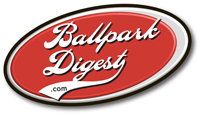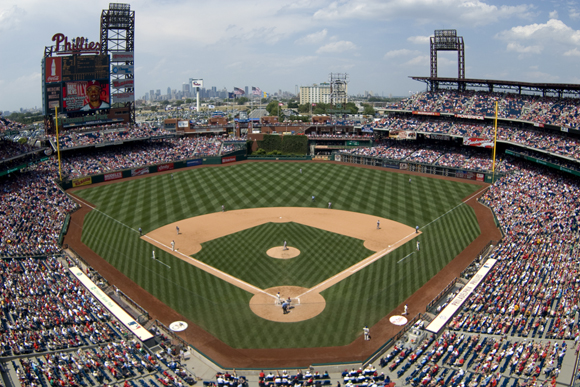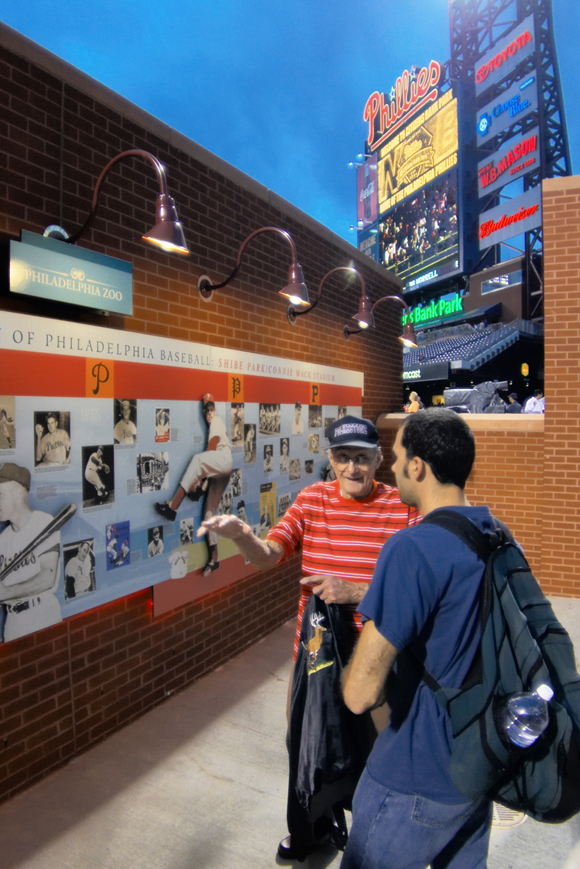Is Citizens Bank Park the best ballpark in baseball? While its location keeps it from being considered the best overall ballpark, it certainly is in the top echelon of Major League Baseball ballparks. With the place crammed regularly with enthusiastic fans, it’s also one of the most popular MLB ballparks, and after eight seasons, it’s still in great shape.
FAST FACTS
Year Opened: 2004
Capacity: 43,651
Suites: 70
Cost: $346 million
Architect: EwingCole, Philadelphia, and Populous, Kansas City
Owner: City of Philadelphia
Dimensions: 334L, 374LC, 387LC, 409 “The Angle,” 401C, 398RC, 333R
Fence Heights: Left field, 10’6”; Center field, 6’; “The Angle,” 19’-12’8”; Right field, 13’3”.
Naming Rights: Citizens Bank, $95 million over 25 years; $57.5 million for naming rights and $37.5 million for the Phillies broadcast media package.
Playing Surface: Grass.
Website: mlb.com
Ticket Prices: Field (115-132), $60; Field (108-114, 133-139), $45; Scoreboard Porch (241-245), $38; Terrace (312-329), $34; Field (140-148, 101-107), $33; Pavilion (206-211), $33; Arcade (233-237), $33; Foul Pole Seats (107, 140-141), $33; Pavilion (201-205), $28; Foul Pole Seats (205), $28; Terrace (330-333), $26; Terrace Deck (412-429), $26; Pavilion Deck (306-310), $26; Foul Pole Seats (306), $26; Pavilion Deck (301-305), $20; Terrace Deck (430-434), $20; Foul Pole Seats (305), $20; Standing Room Only, $17.
Ticket Lines: 215/463-1000
League: National League
Phillies Dugout Location: First-base side.
Other Tenants: None.
Previous Names: None.
First Game: On April 12, 2004, the Philadelphia Phillies opened Citizens Bank Park with a 4-1 loss to the Cincinnati Reds before a crowd of 41,626. Bobby Abreu homered for the only Phillies run of the game. Reds ace Paul Wilson gave up that single run in 7.1 innings of work to earn the victory. The Phillies earned their first win at Citizens Bank Park the following day with a 6-4 victory over the Reds, rallying for six runs in the seventh and eighth innings. David Bell and Mike Lieberthal homered for the Phillies.
Address: One Citizens Bank Way, Philadelphia, 19148-5249
Directions: Citizens Bank Park is located in the same southeast Philadelphia sports complex with Lincoln Financial Field (home to the NFL’s Philadelphia Eagles) and Wachovia Center (home to the NHL’s Philadelphia Flyers and the NBA’s Philadelphia 76ers). The SEPTA Broad Street Subway Line terminates at the sports complex at Pattison Avenue. The Broad Street Line runs north-south through Philadelphia, beginning to the north at the Fern Rock Transportation Center and terminating to the south at the Pattison Avenue stop next to the sports facilities. The sports complex is only two miles from downtown Philly, so taking the train is a breeze. The sports complex is located between I-75 and I-95, so as long as you know how to get to either freeway you can make it to the ballpark. When on I-95 exits 17 and 19 will take you directly to the ballpark. If you’re staying downtown, take Broad Street south and you’ll be right there. 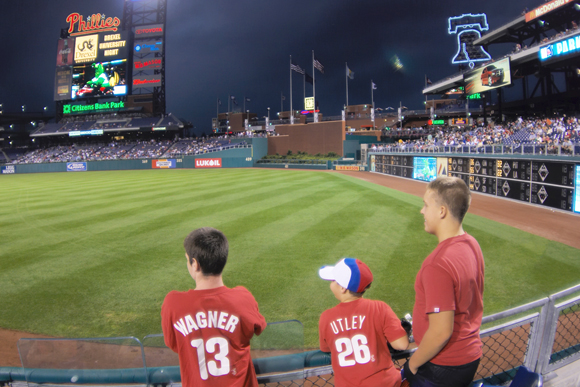 It seems a generation ago when Citizens Bank Park first opened; since then several new MLB parks have opened, each building upon the blueprint that makes Citizens Bank Park such a success. Indeed, it’s hard to remember those dreary days at the Vet, given the age of the ballpark and the incredible success enjoyed by the Phillies: three divisional titles, two World Series appearances, a championship crown and a home record of 292-233 since the place opened. It seems like the Bank has been around forever.
It seems a generation ago when Citizens Bank Park first opened; since then several new MLB parks have opened, each building upon the blueprint that makes Citizens Bank Park such a success. Indeed, it’s hard to remember those dreary days at the Vet, given the age of the ballpark and the incredible success enjoyed by the Phillies: three divisional titles, two World Series appearances, a championship crown and a home record of 292-233 since the place opened. It seems like the Bank has been around forever.
That’s perhaps why Citizens Bank Park is sometimes taken for granted when people make their lists of favorite ballparks. True, it is a gorgeous ballpark that’s held up remarkably well since opening. Though it has retro features like brickwork and cozy dimensions, Citizens Bank Park isn’t a true retro ballpark. Its location in the same South Philadelphia sports complex housing Lincoln Financial Field, the Spectrum, and Wachovia Center gives it a definite suburban feel: it’s basically adrift in a sea of parking, a ballpark without context. Though it does afford a lovely view of the downtown Philly skyline from the upper seats in the grandstand, Citizens Bank Park is designed to be as insular as possible: it’s a fairly vertical ballpark, designed to interact very little with the rest of the city.
But it works. The reddish brickwork gives the ballpark a warm feel, while the large scoreboard in left provides a great focal point off the field. The abundance of small touches – Ashburn Alley, above-average concessions, public art – and some unique design decisions make Citizens Bank Park one of the most interesting ballparks in the majors. 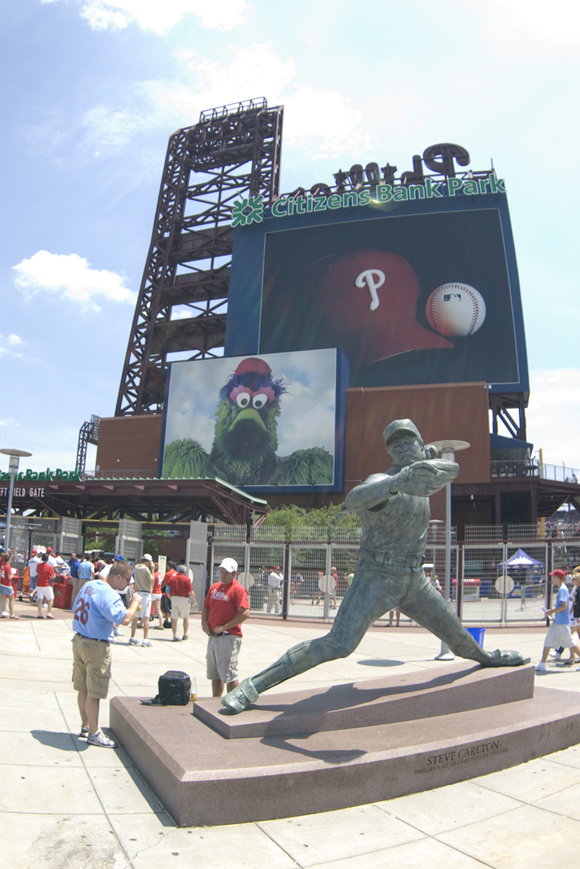
When you go — and if you love ballparks, you absolutely must — take some time to walk around the ballpark before the game. From a distance, Citizens Bank Park isn’t very impressive: it is a ballpark without much context, surrounded by a sea of parking and other sports facilities. Walk all the way around the ballpark before you enter, and you’ll see the four main gates are designed differently. Outside the ballpark there are 10-foot-tall bronze statues of Richie Ashburn, Robin Roberts, Steve Carlton, and Mike Schmidt, all members of the National Baseball Hall of Fame in Cooperstown, done by local sculptor Zenos Frudakis. Also, on the west side of the ballpark is the statue of Connie Mack that once graced the Veterans Stadium and Connie Mack Stadium grounds. 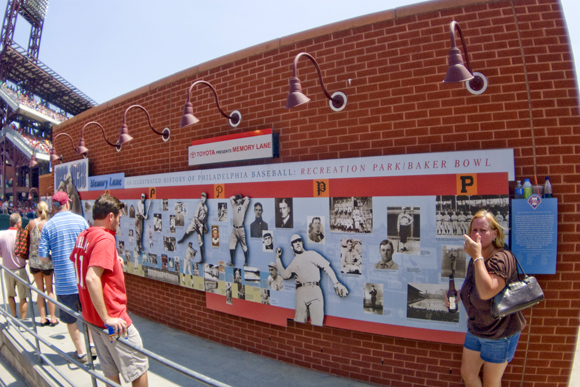
Once inside, head right to the outfield area and spend time in Ashburn Alley. It opens early – 2.5 hours before evening games and three hours before weekend games – and the atmosphere celebrates Philadelphia baseball, from the earliest days of the Philadelphia Quakers to Richie Ashburn’s era to the great teams of the 1970s and 1980s. Memory Lane provides timelines of Philadelphia baseball highlights, including the Phillies, Athletics, and the Negro League teams in the city. Every Phillie All-Star is honored with a commemorative marker, while members of the Phillies Hall of Fame are honored with a bronze plaque. There are food choices galore (we cover them later), and you’ll also be able to watch both starting pitchers warm up in the bilevel bullpens before the game.
In this section you’ll also find seating on top of the buildings, designed to invoke the rooftop seats surrounding Shibe Park in the 1920s. Rooftop seating is actually a grand baseball tradition, dating back to the first days when promoters started charging admission to games, and it’s nice to see that knothole spirit celebrated at the ballpark, albeit limited to groups. (Before we get too weepy with nostalgia, let’s also point out it’s a really clever way to monetize space a great distance away from the playing field.) Theater-style seats are above Harry the K’s; bleachers are installed under the Liberty Bell.
The ballpark is aggressively asymmetrical. The outfield fence goes beyond being merely asymmetrical: it contains an “Angle” that juts into play. (We discuss it more in the next section.) The upper deck and the lower deck don’t match up, there’s a break in the grandstand near section 210 (with the right-field pavilion sitting lower than the grandstand), and there’s more seating in the right-field corner than the left-field one. The break is more than a designed quirk: its platform provides views of the game and the Philadelphia skyline. 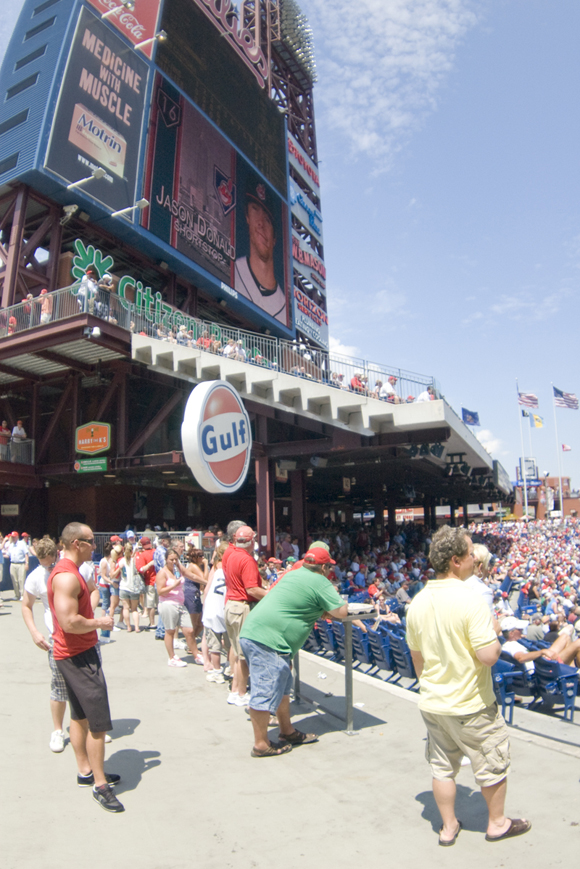
There is also plenty of eye candy once the game starts. When the Phillies homer, a neon Liberty Bell high above right-center field “rings”: the clapper and the bell appear to move, and a ringing sound is played on the sound system. The Liberty Bell is large — 35 feet by 50 feet — and it occupies a perch 100 feet above street level.
And, of course, there’s the massive scoreboard, featuring the largest videoboard in baseball when installed in 2004 (since eclipsed more than once). The scoreboard pretty much dominates the view from any seat, save those in Ashburn Alley and the left-field bleachers, of course) Out-of-town scores are tracked on a videoboard in front of the right-field bleachers: in addition to scores, the game status in terms of runners on base and the number of outs is displayed. One big change since the ballpark opened: Signage is now prevalent at the ballpark. The theory that less is more doesn’t seem to fly here, with 21 permanent billboards seen from the grandstand, and that’s not counting anything on the massive scoreboard or the four ribbon boards. 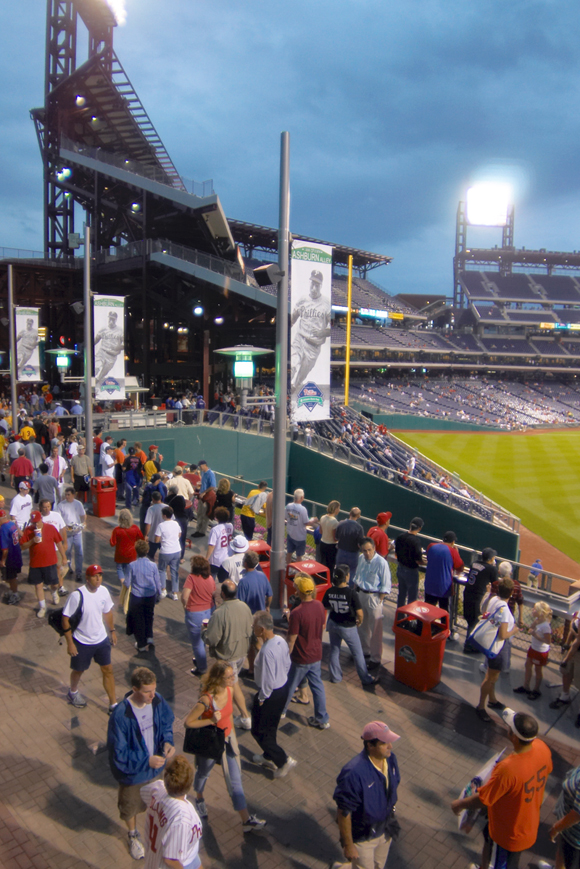
One good thing about Citizens Bank Park: It seems to attract a better class of fan than the Vet did. Philadelphia fans are passionate about their sports, and while that passion sometimes can manifest itself in alarming ways – remember, Philadelphia is where the fans once booed Santa Claus at an Eagles game – we didn’t see too much evidence of boorish behavior at Phillies games, even with larger crowds fueled by playoff fever.
In the end, we had a great time attending Phillies games, and much of that had to do with Citizen Bank Park. It’s a ballpark where all the little touches shine through, from the historic displays in Ashburn Alley to the emphasis on local offerings in the concession stands. There’s nothing generic about Citizens Bank Park — which should make it a prime stop for anyone wanting a great ballpark experience.
BALLPARK QUIRKS
The quirk that impacts play most is the outfield “Angle,” a portion of the outfield fence that juts into play between the left-field power alley and center field. To be honest, it’s a little overboard. In old ballparks odd fences were in response to external factors, not created for sheer entertainment value. When the fence jogged at Griffith Stadium, it’s because the owners of the original Washington Nationals couldn’t acquire all the properties on the block and needed to build around existing properties. At Citizens Bank Park the fence is contrived and unnecessary: in a ballpark where almost every detail is perfect, the fence layout is jarring. 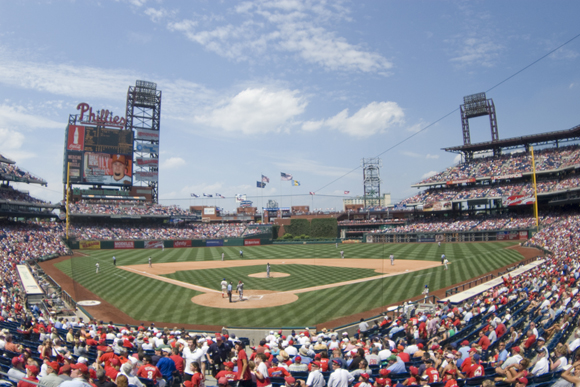
FOOD AND DRINK AT CITIZENS BANK PARK
Apparently it is mandatory for a ballpark to have a BBQ stand, a precedent set by Boog Powell’s stand at Oriole Park. In Philadelphia the barbecue is served up under former Phillie Greg “The Bull” Luzinski’s name in Ashburn Alley. Now, Bull Luzinski is the kind of guy who looks like he’s never walked away from a rack or two of ribs in his life, and apparently he was quite the ribs connoisseur before he signed on as the celebrity name at the Citizens Bank Park barbecue pit. It was a smart signing for concessionaire Aramark: we couldn’t get near the place because of the long lines.
However, that left with probably a dozen solid food choices, including several in Ashburn Alley. Sandwiches are big in Philadelphia, and in Ashburn Alley you have your choice between Philly cheesesteaks from Campo’s Deli and Philly-style sandwiches (including cheesesteaks and pork sandwiches) from Tony Luke’s. Both have their adherents, judging by the long lines in front of both stands.
Neither are excessive as The Schmitter, sold at the stand behind Section 139. Basically, a Schmitter is a cheesesteak on steroids, comprised of fried salami, steak, three slices of cheese, tomatoes and a special sauce. It was originated at McNally’s Tavern in Chestnut Hill.
Also represented in Ashburn Alley and other Citizens Bank Park: crab fries from local watering hole Chickie’s & Pete’s, hoagies from local chain Planet Hoagie and Turkey Hill ice cream. (You can also find Turkey Hill ice cream at multiple stands on the main concourse.) Microbrews and sandwiches are sold at the Brewerytown stands; we tallied an impressive number of beers available on tap, including Flying Fish, Sam Adams, Anchor Steam, Victory Hop Devil, Sly Fox and Yuengling.
INSIDER’S TIP
In an effort to bring fans to the ballpark earlier, the Phillies now offer concession specials for the first hour Ashburn Alley is open. (It opens 2 ½ hours before gametime.) They change game by game, and they’re posted at the Ashburn Alley entrance and the Left Field Gate.
There are, of course, additional concessions past those in Ashburn Alley. Most of the specialty concessions stands on the main level have the same offerings: Hatfield Grills feature Hatfield hot dogs (which are also sold throughout the park), Citizen Bank Park signature hot dogs (tasty; try one) and Italian sausages, while Philadelphia Water Ice stands offer the local variation on a sno-kone. You can also find generic Philly cheesesteaks at several other stands. Fresh-roasted peanuts are offered at stands behind sections 104 and 137.
If you want something a little more formal, there are three popular sitdown areas at the ballpark. Before the line there’s usually a huge line to eat at Harry the K’s, the Ashburn Alley eatery named after the late Phillies announcer Harry Kalas (perhaps better known as the “Voice of God” on countless NFL Films presentations). McFadden’s Restaurant and Saloon is located outside the third-base gate and has its own entrance. It’s a popular spot before the game, as live music attracts a horde of fans on the outside patio. On the Terrace Level is the High & Inside Pub, a surprisingly elegant bar featuring original artwork. (You can also order Bull’s BBQ there are well — a bonus if you don’t want to wait in line at the main stand.)
Basically, there’s very little reason to go hungry at Citizens Bank Park. We didn’t feel like concession prices were out of line, either, so go hungry to the ballpark.
WHERE TO SIT
Best Sections to View a Game: The Diamond Club seats are wonderful, but they’re also sold out. Our recommendation is to sit down the first-base line in the Field sections (115-132), as you’ll see the action and always have the scoreboard in plain view.
Best Cheap Seats: The cheapest ticket at Citizens Bank Park is $17, but that’s SRO. The cheapest seat is $20, so there’s no such thing as a true cheap seat. Seats in the corners that should be closer to $20 are $33. Then again, you can sit between the dugouts for $60 — and compared to most MLB ballparks, these would qualify as cheap seats. Attending a game at Citizens Bank Park is an expensive proposition if you’re not careful about seat selection.
Worst Seats: There are no really bad seats at Citizens Bank Park: every section and seat are angled toward second base, and sections that are typically wastes of time in ballpark, such as the corner sections, are severely angled to be facing second base. Because Citizens Bank Park is built up vertically rather than horizontally like most new ballparks, it sometimes feel more like a tennis stadium than a ballpark. Be warned, though, that the last two or three rows in the grandstand really should be sold as obstructed-view seats because of the severe overhang of the deck above. If you do sit in the Terrace (upper) Level, sit behind home plate or down the first-base line.
Most Underrated Sections: At the prices you’re paying, no section really is underrated.
At $33, the Field seats in the outfield are a relative bargain: you’re close to the action, but sit in right field to get the best view of the left-field scoreboard. We’re also partial to sections 419-422, priced at $26: you have a great view of all the action, and because of the vertical orientation of the ballpark you don’t feel too far from the action.
HANDICAPPED SEATING
Citizens Bank Park features 700 seats designated for the handicapped. Some are larger spots designed for wheelchairs, while other wider seats are located at the end of rows and featuring movable armrests for easier access. These seats should be a model for anyone looking at accessibility issues in ballparks. 
FOR THE KIDS
There is an abundance of attractions at Citizens Bank Park geared toward kids. In the right-field corner – near the Right Field Gate entrance — are several games, including a monster-sized Baseball Pinball (yes, part of our misspent youth was behind the flippers of a Williams Line Drive pinball; the giant version is a wonderful reminder of the original), a climbing wall, a pitching cage, and other games.
The Phillies merchandise the heck out of the Phillie Phanatic, but it’s all in good taste, and the kids just eat it up. There’s no way a kid will attend a game and not walk away with some sort of Phanatic souvenir: various concession stands sell other Phanatic dolls and T-shirts, while the second level of the Majestic Clubhouse Store is devoted to Phanatic merchandise. Also, the smaller set will enjoy building their own Phillie Phanatic at the Build-A-Bear Workshop located on the Main Concourse near Section 135. (Citizens Bank Park was the only ballpark we visited where an entire concession stand is devoted to DVDs and books. To books. We were awestruck, though in recent seasons the Phillies moved the stand from a prime position in the grandstand to a corner on the Terrace level.)
The Phanatic Phun Zone, geared for kids aged eight and below, is a giant play area. The Phillies say it’s the largest in Major League Baseball.
>Finally, there are two concession stands devoted to kid-sized foods: the Phanatic Phood Stand in Ashburn Alley and the Kid’s Corner, located behind Section 318. Both offer Phanatic Phun Meals, kid-sized hot dogs, drinks and more.
This is only a partial listing of the kid-oriented attractions at Citizens Bank Park. Heck, most kids would be happy with a hot dog and the opportunity to watch the Phillie Phanatic race around the ballpark on his ATV; these additional attractions are the icing on the cake.
BALLPARK TOURS
During the season the Phillies offer tours of the ballpark Monday-Saturday at 10:30 a.m. on non-game days and 10:30 a.m. and 12:30 p.m. During the offseason tours are offered Mondays, Wednesdays and Friday sat 10:30 a.m. Stops include both dugouts, the outfield bullpens, and the Hall of Fame Club. Tickets are $10 for adults and $6 for children (ages 3-14); expect to spend 90 minutes touring. You must preorder your tickets either via the Phillies Web site or by calling 215/463-1000.
LOCAL BASEBALL ATTRACTIONS
You will get all the local baseball history you need in Ashburn Alley; schedule plenty of time before the game to wander through the historic exhibits covering the Phillies, the Athletics, and the local Negro Leagues teams.
Outside the ballpark there are plenty of local baseball attractions. Within the Philadelphia city limits there are markers honoring the former homes of the Philadelphia Phillies and Philadelphia Athletics, Shibe Park/Connie Mack Stadium and Baker Bowl, located within blocks of each other on 21st. To be totally honest, they’re probably not worth a pilgrimage unless you’re a big ballpark geek or a huge Philly baseball fan. (We’re the former, not the latter, so we visited both.) Neither site has anything relating to baseball besides the markers: the Baker Bowl site was converted to warehouse spaces decades ago, while Connie Mack Stadium was torn down in 1976, replaced by an evangelical church. 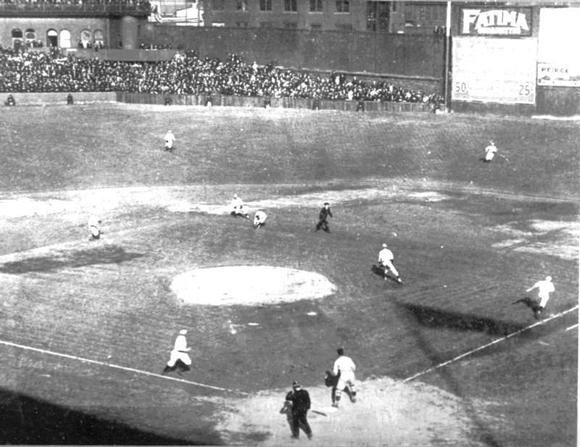
If you have a car, a drive to suburban Hatboro and the Philadelphia Athletics Historical Society is in order. People outside Philadelphia forget that for much of their history the Athletics was the more successful franchise in Philly, with the Phillies running a poor second. Connie Mack led the Athletics to nine American League pennants and five World Series championships. The Historical Society warehouses a trove of Athletics memorabilia: Shibe Park seats, plaques memorializing Athletics of the past, replicas of uniforms, and more. Philadelphia Athletics Historical Society Museum, 6 N. York Rd., Hatboro, PA; 215-323-9901; philadelphiaathletics.org. Open Monday through Saturday, 10 a.m. to 3 p.m., Sunday 11 a.m. to 2 p.m. 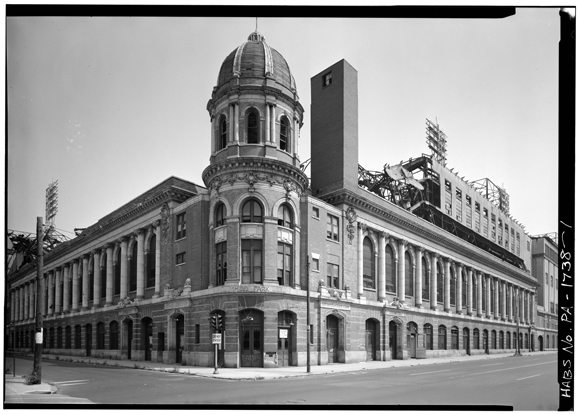
TEAM BALLPARK HISTORY
Considering how long Philadelphia has supported professional baseball, it’s surprising there have been basically four venues for two baseball teams since 1909: Shibe Park (which opened in 1909), the Baker Bowl (which opened in 1887), Veterans Stadium (which opened in 1971), and Citizens Bank Park.
There are parts of Citizens Bank Park designed to evoke memories of Shibe Park, the home of the Philadelphia Athletics from 1909 through 1954 and the Phillies from 1938 through 1970, and Baker Bowl, the home of the Phillies between 1887 and 1937. Both ballparks were close to 21st Street in north Philadelphia.
The Philadelphia Phillies began life as the National League’s Worcester Brown Stockings before Al Reach and Col. John Rogers bought the franchise in 1883 and moved the team to Philadelphia, adopting the Phillies moniker. 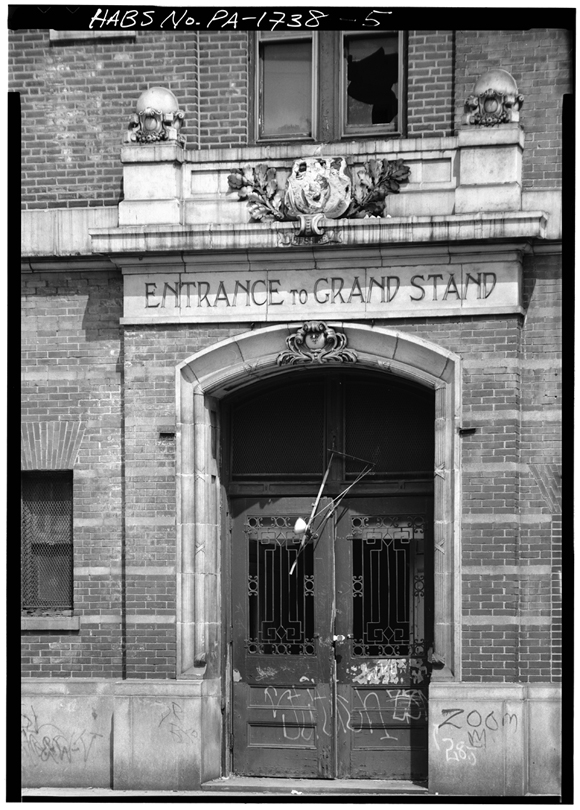
TRIVIA
The Phillies nickname is the longest-running team name in pro sports, although in 1944 and 1945 the Philadelphia front office tried marketing the team as the Blue Jays, placing both names on team jerseys.
The team played at 6,500-seat Recreation Park, located at the corner of 24th and Columbia avenues, before moving to Baker Bowl in 1887. The Phillies were a good draw, and owner Reach saw the building of Philadelphia Base Ball Park — with seating of 12,500 — as a good investment.
And it was an investment: $101,000. Reach spared no expense, using expensive brick for exterior walls and choosing a location in a rapidly expanding residential neighborhood north of downtown Philadelphia. The corner of Broad Street and Lehigh Avenue also provided one additional enticement: it was well-served by mass transit in the form of rail lines and trolley cars. On Opening Day, Reach managed to cram a crowd of 20,000 into the ballpark.
Sadly, Philadelphia Base Ball Park suffered the same fate as many other ballparks of its era: on Aug. 6, 1894, the wooden structure burned to the ground, leaving behind the brick fence. Reach’s response was predictable: he pushed the envelope further and commissioned a cutting-edge ballpark that would be impervious to fire.
National League Park, which opened for the 1895 season, was the first of a wave of modern ballparks opening between 1895 and the 1920s. Wood was eschewed in favor of the more durable and lasting brick and steel, and the new ballpark could seat 18,000.
Adding more seats meant some compromises were made elsewhere, however. At a time when center-field distances of 500 feet were not uncommon, National League Park was an uncommonly intimate ballpark, with the left-field foul pole 341 feet from home plate and the right-field wall only 280 feet out. As you might expect, the unusual dimensions gave the Phillies a tremendous home-field advantage. So did Reach’s installation of a underground wire between the outfield clubhouse and the third-base coaching box, allowing the Phillies to tip off batters.
One thing about Reach: he was not afraid to spend a buck to make a buck, and he invested enough in the on-field product for the team to be constantly competitive: the 1915 Phillies, for instance, drew 449,898 fans en route to the National League pennant and a World Series loss to the Boston Red Sox. (That World Series was known for two firsts: Woodrow Wilson was the first president to attend a World Series game, coming up to Baker Bowl for the second game and throwing out the first pitch, while a young Babe Ruth pinch-hit in the first game.) Reach’s successor, former New York City Police Commissioner William Baker, was the opposite: after taking control of the team in 1913, Baker sold off his stars, slashed costs (using two ewes and a ram to keep the grass low), and renamed National League Park to Baker Bowl. 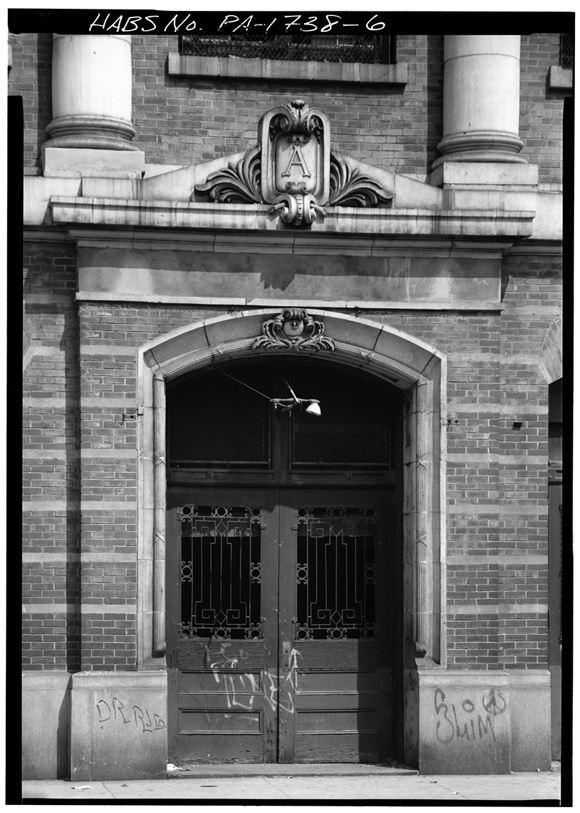
TRIVIA
Baker Bowl’s most historic moment may have come in 1923 when an 11-year-old fan caught a foul ball. At the time many teams insisted foul balls be returned, but the kid demurred. Baker’s front office had the child arrested for larceny and insisted he be taken to jail. A local judge dismissed the charges the following day, and soon after the commissioner’s office decreed all balls hit into the stands be released as souvenirs.
Baker literally drove Baker Bowl into the ground with his parsimonious ways, putting off needed maintenance and continuing to operate the ballpark when safety issues were clearly present. By 1927 the ballpark was literally falling down: the pavilion collapsed when a crowd gathered there during a rainstorm, injuring fifty and killing one. The Phillies managed to play several more seasons at Baker Bowl without killing anybody, but the Great Depression and a long string of losing seasons forced the Phillies to Shibe Park in 1938, where the Phillies and the Athletics could share costs. Despite all the safety issues associated with Baker Bowl — one press pundit called it the “Toilet Bowl” — it remained opened until 1950, when it was finally torn down.
It was a sad end to a once-great ballpark. Hall of Famers Grover Cleveland Alexander and Ed Delahanty had the best years of their storied careers while playing there. The Hilldale Daisies of the Eastern Colored League, a Negro Leagues powerhouse, won the 1925 Negro World Series there, defeating the mighty Kansas City Monarchs.
There are markers commemorating both Baker Bowl and Shibe Park, but they’re not really worth a visit unless you’re a ballpark completist or a Philly baseball fan. The Shibe Park location is now occupied by an evangelical church, while the Baker Bowl location is an industrial site.
Most recently the Phillies played at Veterans Stadium, a mixed-used cookie-cutter ballpark built in 1971 for the Phillies and the NFL’s Philadelphia Eagles. Like most cookie-cutter facilities of the era, Veterans Stadium excelled in neither configuration, but even by cookie-cutter standards the place was a wreck. The Vet was unloved by all; the Phillies sell DVD commemorating the Vet, but it’s really a celebration of the best-loved players from the Vet era, including Mike Schmidt, Larry Bowa, and Steve Carlton. There’s also a plaque near Citizens Bank Park honoring the Vet.
